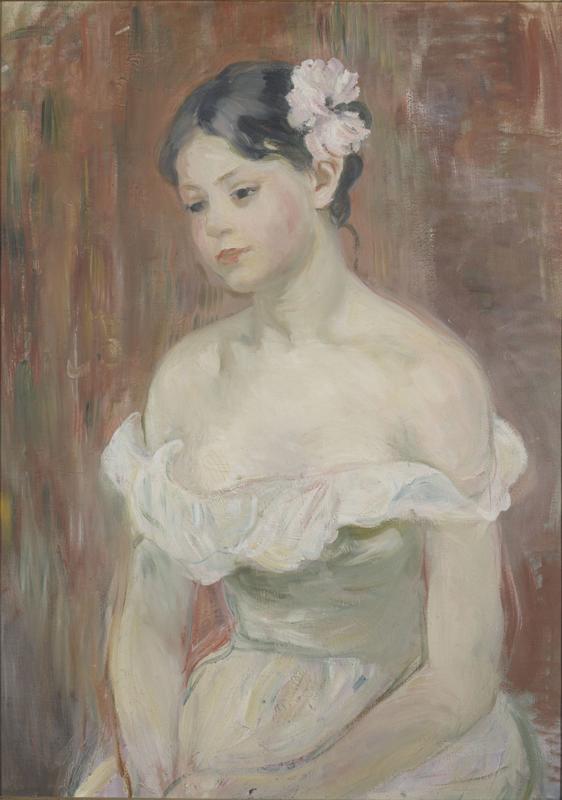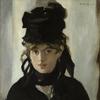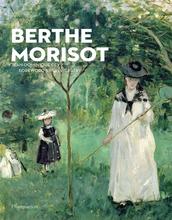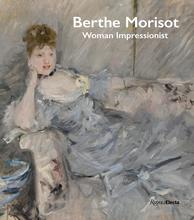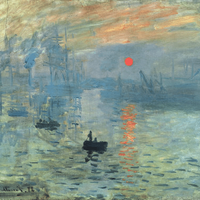More about Young Girl in a Low-cut Dress with a Flower in her Hair
- All
- Info
- Shop

Contributor
Let’s begin by considering the title of this work: Young Girl In a Low-Cut dress with Flowers in Her Hair. Yikes.
Berthe Morisot was a woman in a man’s world, and expectations of representation of women have changed over the hundred-plus years since this work was painted. But still - that is a low-cut dress indeed.
Despite this rather sexualized depiction of her sitter, Marthe, Morisot is a kind of early feminist. Her parents provided her a serious art education and encouraged her to work, and she quickly rose in the ranks of Impressionist artists. She met Manet, and married his brother Eugène, with whom she had a daughter named Julie (who was also an artist, and a frequent sitter for Morisot). Monet was also a close friend, and Renoir remained a favorite throughout Berthe’s life - even coming to meet Julie after her mother’s death. All of this is to say that Morisot stood out in a field flush with men: she was in fact the only person to exhibit in all eight Impressionist group exhibitions at the time, much less the only woman to do so. While in her lifetime she was recognized for the delicate and feminine qualities in her painting (in this work that would manifest as the pink undertones and innocent sitter), she is now known as a groundbreaking female artist, and an Impressionist who stands out for the quality of her work, not just her gender.
So, how do we, as contemporary viewers and conscious consumers, reconcile this dichotomy: badass female artist and painter of questionable youth necklines?
Well, she’s not known for her revealing portraits. Rather, we might think more of women sitting, or lovely pastorals (still often with seated women). The bottom line is that she was a working woman artist who painted women in their daily lives: domestic spaces, on walks, etc. These were obviously women of a certain class, but Morisot still left behind a record of women by women. Would it be a stretch to trace this legacy to Judy Chicago, who investigates femininity through her work? Or even the Guerilla Girls, who point out flaws in systematic representation of women and minorities? I think not - to me this is a perfectly valid line to draw. However, that line comes with the recognition of other lines drawn: such as that of Morisot’s revealing neckline of a minor in this work.
This painting is a beautiful, elegant Impressionist work. Its earthy palette and smooth brushstrokes give the sitter a fabulous realness. The delicacy of Morisot’s floral touch, as well as the hang of Marthe’s dress, are masterful. But still, in a contemporary context there is more to this work, and I believe that Morisot would want us to consider that. In 1890 she wrote: ''I don't think there has ever been a man who treated a woman as an equal and that's all I would have asked, for I know I'm worth as much as they.” That narrative of equality just may have shifted in the years since.
Sources
- “Berthe Morisot.” National Museum of Women in the Arts, accessed 26 May 2019, https://nmwa.org/explore/artist-profiles/berthe-morisot.
- Cascone, Sarah. “Once Overlooked, Impressionist Painter Berthe Morisot Is About to Be Everywhere—Here’s Why.” artnet news, 16 May 2018, accessed 26 May 2019, https://news.artnet.com/exhibitions/impressionist-master-berthe-morisot…
- Dube, Ilene. “Why Berthe Morisot Was an Essential Figure in the Impressionist Movement.” Hyperallergic, 31 October 2018, accessed 26 May 2019, https://hyperallergic.com/468570/why-berthe-morisot-was-an-essential-fi….
- Kline, Nancy. “Great Art, Repugnant Politics.” New York Times, 8 December 2017, accessed 26 May 2019, https://www.nytimes.com/2017/12/08/books/review/growing-up-with-impress….
- Truitt, Anne. “A First Impressionist.” New York Times, 3 June 1990, accessed 26 May 2019, https://www.nytimes.com/1990/06/03/books/a-first-impressionist.html.
- Whitmore, Janet. “Berthe Morisot: Woman Impressionist.” Nineteenth Century Art Worldwide, accessed 26 May 2019, https://www.19thc-artworldwide.org/spring19/whitmore-reviews-berthe-mor….
- Wilson, William. “Berthe Morisot - Heavyweight Impressionist.” Los Angeles Times. 20 September 1987, accessed 26 May 2019, https://www.latimes.com/archives/la-xpm-1987-09-20-ca-9328-story.html.
- “Young girl in a low cut dress with a flower in her hair.” Petit Palais Paris, accessed 26 May 2019, http://www.petitpalais.paris.fr/en/oeuvre/young-girl-low-cut-dress-flow….

